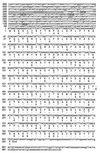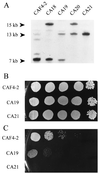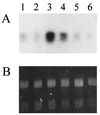Monosomy of a specific chromosome determines L-sorbose utilization: a novel regulatory mechanism in Candida albicans
- PMID: 9560244
- PMCID: PMC20229
- DOI: 10.1073/pnas.95.9.5150
Monosomy of a specific chromosome determines L-sorbose utilization: a novel regulatory mechanism in Candida albicans
Abstract
We report the identification of the gene, SOU1, required for L-sorbose assimilation in Candida albicans. The level of the expression of SOU1 is determined by the copy number of chromosome III (also denoted chromosome 5), such that monosomic strains assimilate L-sorbose, whereas disomic strains do not, in spite of the fact that SOU1 is not on this chromosome. We suggest that C. albicans contains a resource of potentially beneficial genes that are activated by changes in chromosome number, and that this elaborate mechanism regulates the utilization of food supplies and possibly other important functions, thus representing a novel general means for regulating gene expression in microbes.
Figures





Similar articles
-
Candida albicans SOU1 encodes a sorbose reductase required for L-sorbose utilization.Yeast. 2005 Sep;22(12):957-69. doi: 10.1002/yea.1282. Yeast. 2005. PMID: 16134116
-
CSU57 encodes a novel repressor of sorbose utilization in opportunistic human fungal pathogen Candida albicans.Yeast. 2021 Mar;38(3):222-238. doi: 10.1002/yea.3537. Epub 2020 Dec 29. Yeast. 2021. PMID: 33179314
-
Adaptation of Candida albicans to growth on sorbose via monosomy of chromosome 5 accompanied by duplication of another chromosome carrying a gene responsible for sorbose utilization.FEMS Yeast Res. 2014 Aug;14(5):708-13. doi: 10.1111/1567-1364.12155. Epub 2014 May 13. FEMS Yeast Res. 2014. PMID: 24702787 Free PMC article.
-
Appearance and properties of L-sorbose-utilizing mutants of Candida albicans obtained on a selective plate.Genetics. 1999 Oct;153(2):653-64. doi: 10.1093/genetics/153.2.653. Genetics. 1999. PMID: 10511546 Free PMC article.
-
The molecular genetics of Candida albicans.Microbiol Sci. 1988 Feb;5(2):58-63. Microbiol Sci. 1988. PMID: 3079219 Review.
Cited by
-
Nonsex genes in the mating type locus of Candida albicans play roles in a/α biofilm formation, including impermeability and fluconazole resistance.PLoS Pathog. 2012 Jan;8(1):e1002476. doi: 10.1371/journal.ppat.1002476. Epub 2012 Jan 12. PLoS Pathog. 2012. PMID: 22253594 Free PMC article.
-
Chromosome 5 monosomy of Candida albicans controls susceptibility to various toxic agents, including major antifungals.Antimicrob Agents Chemother. 2013 Oct;57(10):5026-36. doi: 10.1128/AAC.00516-13. Epub 2013 Jul 29. Antimicrob Agents Chemother. 2013. PMID: 23896475 Free PMC article.
-
A single-transformation gene function test in diploid Candida albicans.J Bacteriol. 2000 Oct;182(20):5730-6. doi: 10.1128/JB.182.20.5730-5736.2000. J Bacteriol. 2000. PMID: 11004171 Free PMC article.
-
Aneuploid chromosomes are highly unstable during DNA transformation of Candida albicans.Eukaryot Cell. 2009 Oct;8(10):1554-66. doi: 10.1128/EC.00209-09. Epub 2009 Aug 21. Eukaryot Cell. 2009. PMID: 19700634 Free PMC article.
-
Widespread occurrence of dosage compensation in Candida albicans.PLoS One. 2010 Jun 11;5(6):e10856. doi: 10.1371/journal.pone.0010856. PLoS One. 2010. PMID: 20552010 Free PMC article.
References
Publication types
MeSH terms
Substances
Associated data
- Actions
Grants and funding
LinkOut - more resources
Full Text Sources
Other Literature Sources
Molecular Biology Databases

